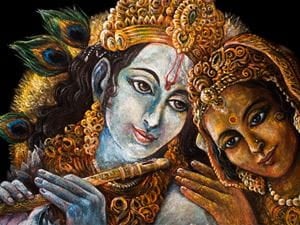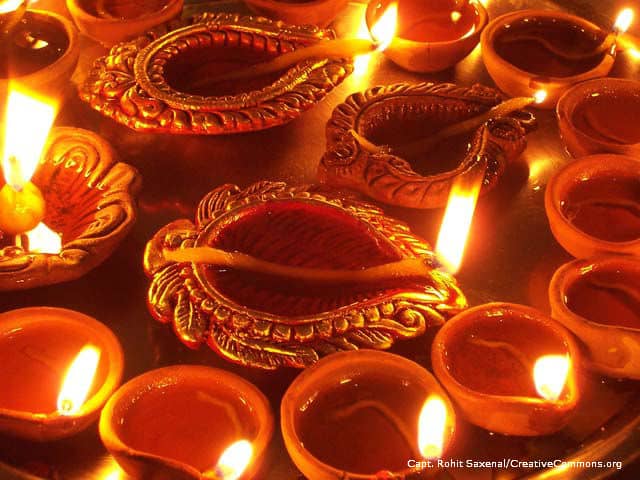
Krishna is believed by most Hindus to be one of the earthly incarnations of Vishnu, who is the second god in the supreme Hindu triumvirate.
According to Hindu legend, Mother Earth was upset by the atrocities being committed upon her, and so she went to the Hindu gods for help. Vishnu, after hearing her, agreed that he would be born into a human avatar on Earth, and that this avatar would put a stop to the rampant human sin that was happening at the time.
He was born to a human mother, Devaki , and father, Vasudeva, of the Chandravanshi clan, in an era of persecution and chaos—a time when freedom was denied and evil reigned. Upon his palms were the sign of the lotus, and he came into this world adorned with jewels and wearing a crown.
Krishna’s uncle, Kamsa, was the source of the atrocities of which Mother Earth complained. A tyrannical ruler, he was told by fortune tellers that one of Devaki’s sons would come to kill him, and so he arranged to kill each of her sons.
When Krishna was born, however, his father secreted him away, exchanging him for a female child from a neighboring region. When Kamsa came to kill the child, the exchanged infant appeared as the goddess Durga, who warned Kamsa that death had come for him and his kingdom before disappearing.
As a boy, Krishna was said to be mischievous, and a prankster, as well as a courageous and well-loved protector who battled serpents, moved mountains, and loved all. When he grew to become a man, he returned to his homeland and killed the tyrant Kamsa, reinstating his father, Vasudeva, as king.
The god of compassion, tenderness, love, and beauty, Krishna is also associated with heroism and power. He is a popular god, and is widely revered, making this celebration an important one in Indian culture.
Let’s take a look at the many ways in which the birth of this important god is celebrated throughout India.
Diverse Celebrations
Janmashtami is celebrated over two days, with the first day being known as Krishan ashtami, and the second day, as Hanam ashtami. Over this 48-hour period, many Hindu celebrants participate in the festival rather than sleep—festivities commence at midnight, when Krishna is traditionally thought to have been born.
On the first day, Hindus rise before dawn, engaging in prayer and song in honor of Krishna. Many Hindus also fast during Janmashtami, breaking their fact only once these midnight celebrations begin, and food prepared from the milk and curds said to have been favored by Krishna is served on the second day.
At midnight, statues of baby Krishna are bathed and dressed to commemorate the god’s birth, and the air is filled with the sound of ringing bells and blown conch shells.
Janmashtami is known in some Indian cities as Dahi Handi, which translates to “earthen pot of yoghurt.” This name comes from the legends surrounding the young Krishna. According to these tales, the infant god would steal yoghurt and butter, and those around him had to hide their dairy supplies in high-hanging pots to keep the little prankster away from them.
Because of this, Dahi Handi involves pots of yoghurt being hung from tall poles or from the second or third floors of buildings. Teams of young boys called “Govindas” climb upon one another, forming human pyramids to reach and break the pots. Young girls surround the boys, cheering, dancing, and singing. When the pots are broken, the spilled yoghurt is considered a celebratory offering, and prizes are awarded to those who are the quickest.
In Northern India, Janmashtami is one of the largest festivals of the year. Krishna temples are decorated with strands of lights, attracting multitudes of visitors. Dance and drama events are held in honor of Krishna, highlighting the god’s love affairs and childhood mischief, and kites are flown from the rooftops.
In Eastern India, the tradition of dressing children up as characters from the legends surrounding Krishna is common, and temples are decorated with flowers and leaves as groups recite stories of the god.
Here, the dramatic arts are of utmost importance, and the love-affairs of Krishna are celebrated through classical dance forms and music.
In South India, this celebration is known as Gokulashtami. Here, Hindus decorate floors with kolams, which are decorative patterns drawn with rice batter, and draw the footprints of Krishna, depicting the god’s arrival to their homes.
Food is important to these celebrations, and offering to Krishna include butter, fruits, and savories which Krishna is believed to have loved. The most important of these is Seedai, a food made with butter, raw rice, and sesame seeds, which are rolled into balls and fried.
Young boys are dressed as Krishna, visiting friends and neighbors, and the youngest male of each family is placed on a swing and rocked gently in reverence to the young Krishna.
The Significance of Krishna
Krishna is beloved throughout the Hindu world for good reason—not only is he an incarnation of one of the supreme gods of the Hindu tradition, but he is also representative of some of the best parts of human life. Good-natured mischief, free-spirited love, and stout-hearted heroism are all bound up into the tales of Krishna—he is the embodiment of bliss and happiness.
These qualities stand in opposition to the human ego, which is the enemy of love. Krishna is representative of the birth of love within the human heart, and the power it has to destroy the tyranny of ego and lonely selfishness.
When Janmashtami comes, remember to give thought to this inner conflict, and to the surprising joy that can come from the defeat of the ego. Whatever your beliefs, Krishna represents the very best of what is within us as human beings.

